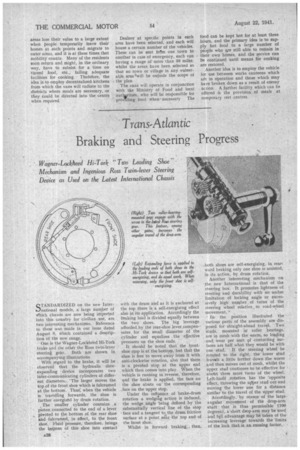Trans-A tlan tic
Page 38

If you've noticed an error in this article please click here to report it so we can fix it.
Braking and Steering Progress
STANDARDIZED on the new International models, a large number of Which chassis are now being imported into this country for civilian use, are two interesting mechanisms.. Reference to these was made in our issue dated August 8, which contained a description -of the new range.
One is the Wagner-Lockheed Hi-Tork brake and toe other the Ross twin-lever steerink gear. Both are shown in accompanying illustrations.
With regard to the brake, it will be observed that the hydraulic shoe' expanding device incorporates two inter-communicating cylinders of different diameters.. 'The larger moves the top of the front shoe which is fulernmed at the bottom. Thus; when the vehicle is 'travelling forwards, the shoe is further energized by drum rotation.
The smaller cylinder contains ,a piston connected to the end of a lever pivoted to the bottom of the rear shoe • and fulcrumed, in effect, to the front shoe. Fluid pressure, therefore, brings the bottom of this shoe into contact
with the drum and as it is anchored at the top there is. a self-energizing effect also in its application. Accordingly the braking load is divided equally between the two shoes. The big leverage afforded by the rear-shoe lever _compensates for the small diameter of the cylinder and equalizes the effective pressures on the shoe ends.
It should be noted that the frontshoe stop is at the bottom, but that the shine is free to move away from it with anti-clockwise rotation, also that there is a pivoted stop at the upper end which then comes into play. When the vehicle is running in reverse, therefore, 'and the brake is applied, the face on the shoe abuts on the corresponding _face on the upper stop.
Under the influence of brake-drum rotation a wedging action is induced, the wedge angle being defined by the substantially vertical line of the stop • face and a tangent to the drum friction surface at a point ngar the top end of the front shoe.
Whilst in forward braking„ then, .both shoes are self-energizing, in rearward braking only one shoe. is assisted, in its action, by drum rotation.
Another interesting mechanism on the new International is that of the steering box. It promotes lightness of steering and durability with no undue limitation of locking angle or exces sively high number , of turns of the steering wheel relative _ to road-wheel movement.
In, the position illustrated the
various parts of the assembly are disposed for straight-ahead travel. Two studs, mounted in roller bearings, are in mesh with the w,orrn, so loading and wear per unit of contacting sur faces are half what they would be with one 'stud. If the steering wheel be
rotated to the right, the lower stud
travels a little farther down the worm and then moves out of mesh, whilst the upper stud continues to be effective for about three more turns of the wheel.
Left-han'd rotation has the 'opposite effect, throwing the urfper stud out and moving the lower one for a distance similar to the travel of the upper stud. Accadingly, by reason of the large angular movement of the drop-arm shaft that is thus permissible (100 degrees), a short drop arm may be used and full advantage may 'be taken of the. increasing leverage towards the limits of the lock that is an ensuing factor.




























































